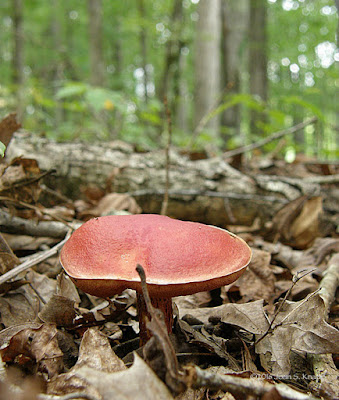August. I saw Frost’s
Bolete (Exsudoporus frostii; formerly
Boletus frostii) for the first time
on another trail in the park.
They were easily
visible from the trail. Two ‘shiny’ red caps. The caps of young Frost’s boletes
are sticky.
When I turned one
over, I could see the red reticulate stem and the red pore surface. (The fluid
isn’t unusual in young specimens; older specimens usually have dry pore
surfaces.) It didn’t take long
to identify this species.
I’ve since found it
in several locations near the trail north, but not south, of the Fishing Area.
This beautiful
specimen was growing between the trail and the reservoir shore.
Another older
specimen, with a still somewhat shiny cap, was growing beside the trail.
The reticulation on the stem is much more pronounced, but less pigmented, in specimens as they age. The pore surface becomes
brownish in older specimens although they still develop the deep blue/black
color that results from bruising, when a colorless compound called boletol is
exposed to air and oxidized to a blue color.
I’ve mentioned, on
occasion, that I often sit or lie on the trail to take photographs. I was lying
just past a slight bend in the trail when I took this photo. A tree in the bend
hid me from other walkers on the trail. I became aware of a walker cautiously
approaching, just out of eyesight. I realized that they could only see my legs
and feet, and were probably wondering if they were encountering a body on the
trail. I sat up and let them know I was a living creature. We laughed.
This isn’t the first time other walkers have wondered if I was OK, but this was
the funniest occurrence, depending on how you look at it.
Exsudoporus frostii had been found widely in eastern North
America, Mexico, and Costa Rica.
References:
Mushroom Expert: Boletus frostii
Discover Life: Boletus
frostii




















































